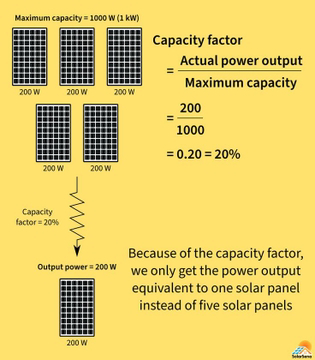The solar capacity factor is a measure of how effectively a solar power system generates electricity compared to its maximum potential output.
It is calculated as the ratio of the actual electricity produced by a solar power plant over a specific period of time (typically a year) to the amount of electricity it would have produced if it were operating at full capacity the entire time.
Mathematically, it can be expressed as:
A higher capacity factor means the system is producing more power relative to its theoretical maximum. Factors affecting the capacity factor of solar energy include:
• Geographic location (more sunlight = higher capacity factor)
• Weather conditions (cloud cover, rain, etc.)
• Time of year (day length, seasonal variations)
• Efficiency of the solar panels
Typically, solar capacity factors range between 15% and 25% for most locations, although it can be higher in areas with consistent sunlight. For comparison, fossil fuel plants usually have capacity factors around 60%-80%.







No comments:
Post a Comment